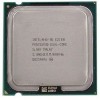Intel E2180 Design Guide - Page 109
Appendix E, Legacy Fan Speed, Control
 |
UPC - 683728169121
View all Intel E2180 manuals
Add to My Manuals
Save this manual to your list of manuals |
Page 109 highlights
Legacy Fan Speed Control Appendix E Legacy Fan Speed Control A motherboard design may opt to use a SIO or ASIC based fan speed control device that uses the existing look up or state based fan speed control. The fan speed control implementations consist of the following items • A motherboard designed with a fan speed controller with the following functionality: ⎯ PWM fan control output ⎯ Remote Digital thermal sensor measurement capability over the PECI bus for the processor ⎯ SST bus thermal sensor to measure the on-die thermal diode for all earlier processors in the 775-land LGA package • A motherboard with a 4 pin fan header for the processor heatsink fan. • Processor heatsink with 4-wire PWM controlled Fan. A thermistor in the fan hub is recommended, but not a requirement. The reference solution and the Boxed Processor will implement a thermistor into the design. The following sections will discuss the necessary steps to implement Legacy Fan Speed Control. Note: For the rest of this section the term "on-die thermal sensor" will be used interchangeably for the Digital thermal sensor or on-die thermal diode. On-die thermal diode will only be used when required for clarity. E.1 E.1.1 Thermal Solution Design The first step is to select or design a processor thermal solution that meets the thermal profile for the processor. See Section 2.2.2 for the definition of the thermal profile and consult the processor datasheet for the specific values. The designer needs to ensure that when the heat sink fan is operating at full speed the thermal solution will meet the TC-MAX limits at TDP. The slope of the thermal profile will allow the designer to make tradeoffs in thermal performance versus the inlet temperature to the processor fan heatsink. Determine Thermistor Set Points A thermistor implemented in the hub of a fan is a first level of fan speed control. It provides an easy and cost effective means to begin acoustic noise reduction. It will, by design, run the fan at an appropriate speed based on the ambient conditions. Chapter 5 and 6 discussed in detail the reference thermal solution, including the target ΨCA, and fan speed based on temperature to ensure that TC-MAX is not exceeded for TDP power at a given ambient temperature. The resulting variable speed fan (VSF) curve is the upper limit on fan speed. Thermal and Mechanical Design Guidelines 109















